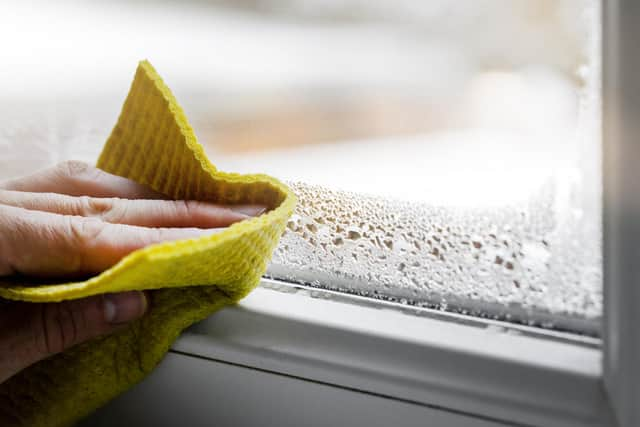Why and where condensation forms in your home and how best to get rid of it
We asked the Green Building Store’s windows department manager, Luke Gilman for his advice and here’s what he told us: In the UK, we generally experience condensation on the inside of our windows or other internal surfaces in our homes, though those who install triple glazedC windows will see condensation on the outside instead.
What causes condensation? The air around us contains water vapour and the amount of vapour in the air is the humidity level.
Advertisement
Hide AdAdvertisement
Hide AdZero per cent humidity means no water vapour is in the air and 100 per cent means it is fully saturated and this is known as the dew point when the vapour condenses out as water droplets.


When this happens, because the air has hit a cold surface, at or below the dew point, the water is deposited on that
surface as condensation.
Most humidity in our homes is a result of our lifestyles. Humans all contribute to water vapour in the
house by breathing and sweating.
If we add to that our cooking, washing and drying clothes, a lot of water is potentially added to our indoor environment. The risk of condensation forming in a property is mainly on cold surfaces, such as windows, mirrors, ceramic tiles and external walls.
Advertisement
Hide AdAdvertisement
Hide AdIt also forms on cold surfaces where air movement is limited and can’t dry out again, so typically behind pieces of furniture set against a cold wall or inside a fitted wardrobe on an external wall.
This year, as we have all been careful to keep indoor temperatures down to save on energy bills, condensation has become a bigger issue.
You should be concerned about excessive and repeat condensation in your home for several reasons: the optimum humidity for your house is between 40-60 per cent.
High humidity can impact health most notably due to it facilitating the growth of black mould, which, as we saw tragically in Rochdale, can be life-threatening.
Advertisement
Hide AdAdvertisement
Hide AdIt is common to see black mould on walls and the seals around your windows where the edge of the glazing is cold and in the seals of a shower.
You should clean off the mould carefully, using a proprietary fungicidal solution without raising any dust, which will contain black mould spores.
As well as the health risk, excessive condensation on surfaces can damage your home, causing paint peeling and cracking, and rot in timber windows or window boards.
You can reduce the risk of condensation in your home by reducing the humidity, which is easier said than done. Here are some measures you can take to reduce the humidity in your home:
Advertisement
Hide AdAdvertisement
Hide Ad*You should reduce the amount of clothes drying on radiators by using a tumble dryer or or heated enclosed airer, such as a Drysoon.
*You can also buy small condensation absorbers/traps from around £4 to £5 to collect moisture from around windows, in bathrooms, wardrobes and utility rooms. Lakeland are among those who sell them.
*When showering and bathing, ensure the bathroom is well-ventilated by putting on the extractor fan or temporarily opening a window.
*When cooking, use the extractor hood or again open a window for a while.
Advertisement
Hide AdAdvertisement
Hide Ad*Reduce the number of cold surfaces by insulating walls and having better ventilation.
*Windows and doors are usually the weakest points of a home regarding heat loss.
*If you have single glazing or older double glazing, you need to consider upgrading unless you are restricted by Listed Building status.
*The best defence when it comes to windows is triple glazing, which is much more energy efficient than double. The warm internal pane of the window means there isn’t a chance for condensation to form on it and there is no feeling of cold coming in.
Advertisement
Hide AdAdvertisement
Hide AdThe extra pane of glass has a special coating to keep heat in the building and, combined with the extra argon filled cavity, this makes a real difference.
A triple glazed window can have around half the heat loss of the best quality modern double glazed window and, as mentioned, condensation only forms on the outside pane.
A good triple glazed window can bring in valuable solar gains and help keep the warm air in the building for longer too.
So, if you see condensation inside your windows, you need to consider all of the above but if you see condensation on the outside of your windows, you should celebrate, as it means you have efficient windows and a healthier home.
Advertisement
Hide AdAdvertisement
Hide AdA similar effect can be seen when it snows. If the snow stays on your roof longer, you have better insulation and are losing less heat from your home.
*The Green Building Store has a showroom in Huddersfield, www.greenbuildingstore.co.uk